Take it offline!
This Education in Motion resource is also available as a printable PDF.
Download PDF
Jessica Presperin Pedersen created a webinar entitled, "Air Travel with a Wheelchair: What the Wheelchair and Seating Professional Should Know." It is available to watch for free on Education in Motion or can be purchased for CEU credit. This resource is the handout that accompanies the webinar and provides some of the resources discussed.
Flying with a wheelchair has its challenges. Riders, families, airlines, airports, disability groups, wheelchair manufacturers, suppliers, and therapists have been working together to come up with processes and equipment to make the trip successful and uneventful. The webinar reviews the process of traveling with a wheelchair, including:
- Ordering the ticket online
- Requesting proper assistance at airports
- Protecting the wheelchair to minimize damage in stowage
- Sharing information about equipment with the below-the-wing crew to protect a wheelchair traveling in stowage
- Transferring onto the aircraft
- Sitting safely on the aircraft seat
- What to do if equipment is lost or damaged
- Advocacy and legal information
- Designs for in-cabin wheelchair travel
The webinar is meant for riders and their families who may not have traveled by air with a wheelchair, and therapists and suppliers who may be the first professional to discuss travel by air with new wheelchair riders.
Sunrise Medical is committed to making travel easier by being actively involved in the Assistive Technology for Air Travel Standards group of RESNA and working with advocacy organizations who focus on travel with a wheelchair. Sunrise Medical complies with mandates from the Department of Transportation and worldwide groups, and partners with companies designing ways to allow wheelchairs to be brought into the cabin, allowing the riders to sit in the wheelchair during the trip. We will continue to update readers on the latest policies and regulations regarding travel with a wheelchair and design products for safe transportation.
Online Ticketing
Most airline tickets are purchased online. The airline provides a way to indicate if a wheelchair is being used during the ticketing process. The seating assignments might allow the choice of a seat with extra legroom. Many airlines will provide information as to the type of aircraft being flown, which can indicate the size of the cargo door and below-the-wing storage. This information might allow one to decide if they want to take a different flight on a larger aircraft if the cargo space is too small for a power wheelchair to be transported upright. It is highly recommended that the airline be contacted the day before the flight to provide information that a wheelchair is being used and what transfer assistance is needed.
Wheelchair reporting during the ticketing process
Many airlines have fields on the ticketing form to provide information pertaining to the wheelchair. Specifics to fill out include:
- Width and height (tilted or folded) to get into the cargo hold
- Weight (unoccupied mass). This will determine where the wheelchair can be positioned in the cargo hold.
- Type of wheelchair (manual or power)
- Batteries
- Type: gel, non-spillable, lead-acid, lithium-ion
- How many
- Lithium-ion batteries: list watt-hour rating (must be transported in the cabin)
- If it is key-operated
- If it can be folded or collapsed
- If there are removable parts and if any removable parts will be taken into the aircraft cabin
- If any tools are needed
- Special instructions
Baggage
Anything medically related is not included in the baggage count. This might include:
- Shower chair
- Sports chair
- Medications
- Catheter/bladder and bowel management supplies
- Any items removed from the wheelchair and taken onto the aircraft
- Cushion and support devices for the aircraft seat
- Duct tape
- Zip ties
- Pneumatic tubes for tires
- Plastic roll to wrap around wheelchair
- Cover or bag for wheelchair for protection (some are commercially available)
- Towel (standard for catheter emptying)
- Gel cell battery charger if not going into the cargo hold)
- Labels with contact information that will be attached to equipment going into stowage areas
Check-In
- Arrive two hours before domestic flights when traveling with a wheelchair. This will ensure enough time to get the wheelchair into the cargo hold.
- Identify needs to the ticket agent or at the disability office.
- Let them know you need a boarding chair
- Let them know you are taking your own wheelchair to the gate
- Indicate how much assistance you will need for transfers
- TSA will do pat-down
TSA Check
Everyone must go through TSA. If an individual cannot walk through the security scanning door, the person and the wheelchair will have to be wanded. Sometimes a dog may be called in as well to assure that the wheelchair and traveler are compliant. The TSA agent has some training but may not know how to work with people with disabilities and not understand a person's limitations. The individual or caregiver may need to inform the TSA agent that they are not able to lean forward or raise their arms for scanning. If the traveler has TSA pre-check, wanding may be waived or less detailed.
Lavatory/Restroom Use
Lavatories in single-aisle aircraft are small, so many people who use a wheelchair will use the restrooms before the flight. Sometimes, in order to make it through a long flight, people will dehydrate or wear diapers.
Changing places
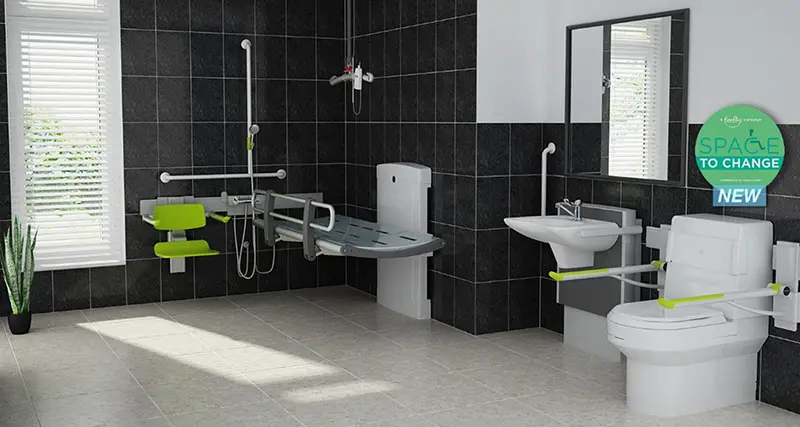
Before the inclusion of adult changing stations, adults who were not able to use a toilet and needed to have a diaper change were often laid on a blanket on the bathroom floor. Dignity and privacy were not an option. The first changing place stations were built in the UK in the early 2000s, thanks to Loretto Lambe, and a charity called Promoting a More Inclusive Society. These advocates showed pictures of families changing adult children on the floors of public bathrooms. Those photos and the mother's persistence caused the very first changing station to be built in the UK. There are now over 600 changing stations in the UK. It took several years before the first changing station was built in the U.S. in 2017, but now there are several. Efforts are being made for every airport to have at least one changing station in each terminal. Hopefully, the call for adult changing stations at other venues such as shopping centers and sports arenas will be heard as well.
Onboarding
Onboarding is the process of getting out of the wheelchair and transferring into the airline seat.
- Transfer directly to airline seat
- If the rider can take a few steps to walk down the aisle
- If the door and entryway of the aircraft allow for the chair to get to the front seats
- Transfer to boarding chair
- There are different types of boarding chairs. They all have to fit int he aisle of the aircraft, so they are often less than 15 inches wide. Transfers to and from the boarding chair may be difficult. Some boarding chairs have armrests while others do not. None have decent pressure distribution.
- A mechanical lift that can enter the aircraft and lift a person onto the seat using a sling mechanism may be available at the airport.
- Do not transfer into the boarding chair until the rider is ready to go onto the aircraft, as pressure distribution is poor and there is little to no support on the boarding chair.
- The transport team can help with transferring. The rider or family should direct the transfer process.
- All straps on the boarding chair should be used for safety.
- The rider may use their wheelchair cushion on the boarding chair if able to incorporate it into the transfer.
- Transfer to airline seat
- The armrest on the aircraft seat may or may not lift up to get out of the way for a transfer.
- The rider may use their wheelchair cushion for skin protection.
- Direct two-person lift into airline seat
...or...
- Independent transfer
- Transfer sling
- The transfer sling shown below may assist the people doing the transfer and provide a safer method decreasing the potential for a drop or fall. Some transport companies doing the transfer may have them in their arsenal. Riders and families have purchased them to ensure they always have one for use during travel.
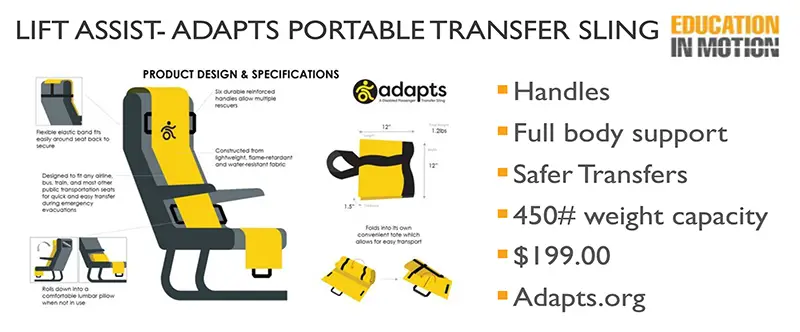
Cushions and support on aircraft seat for pressure distribution or stability
- Seating surface interface pressure
- Boeing aircraft: standard cushion can be replaced with wheelchair cushion
- Air pressure changes for air cushions: may have to release air in flight
- Many people have body support systems in their wheelchairs which cannot be transferred to the aircraft seat. Straps that wrap around the chest and the back of the chair might prevent falling forward during landings.
Stowage of Wheelchair in Cargo Hold
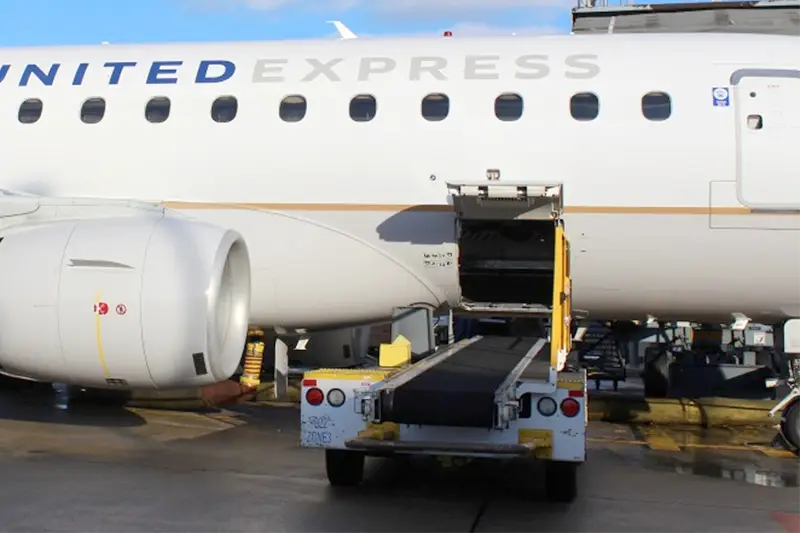
The cargo doors vary in size depending on the aircraft. The cargo hold also varies in size. This will determine if the wheelchair can be pushed upright through the cargo door and stay upright during the flight.
What riders can do to protect the wheelchair
Sometimes, damage to the wheelchair occurs when it is dropped or falls off the conveyor belt as it enters the aircraft cargo hold. Most damage to wheelchairs happens below the wing due to turbulence during the flight. The below-the-wing crew will not put anything on top of the wheelchair, but that doesn't mean things won't fall on top of or into the chai during the flight.
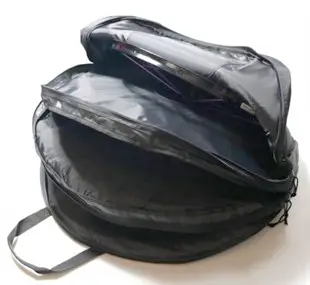
There are commercially available bags for manual wheelchairs and wheels. While these bags will not protect the wheelchair during a fall, it might protect from scratches and bumps.
The suggested position for a power wheelchair is to fold down the back if possible or put the wheelchair in a reclined and tilted position to get it below 33" in height, allowing it to go through a cargo door.
- Remove joystick or bring inward, or wrap
- Remove cushion and headrest
- Place chair into tilt and recline to allow entrance through cargo door
- Wrap in plastic
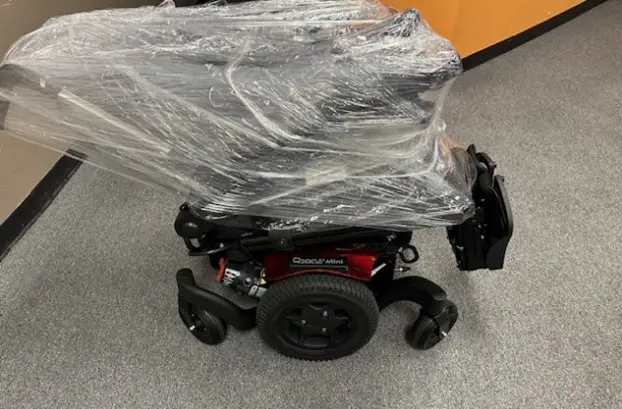
Moving the joystick inward and wrapping the entire wheelchair in plastic may prevent damage from things falling on the chair. The plastic is tight and objects literally bounce off the chair. Plastic rolls can be found at hardware stores in their moving/packing section or in stationery stores in their mailing section.
Tags to identify wheelchair and provide information pertaining to the wheelchair
The RESNA Assistive Technology and Air Travel (ATAT) Standards committee has developed some suggestions for air travel. This tag is designed to provide the airlines with needed information. It includes photos of the rider's wheelchair in the folded or reduced height position, with measurements. Weight, type of batteries, and key information can be provided.
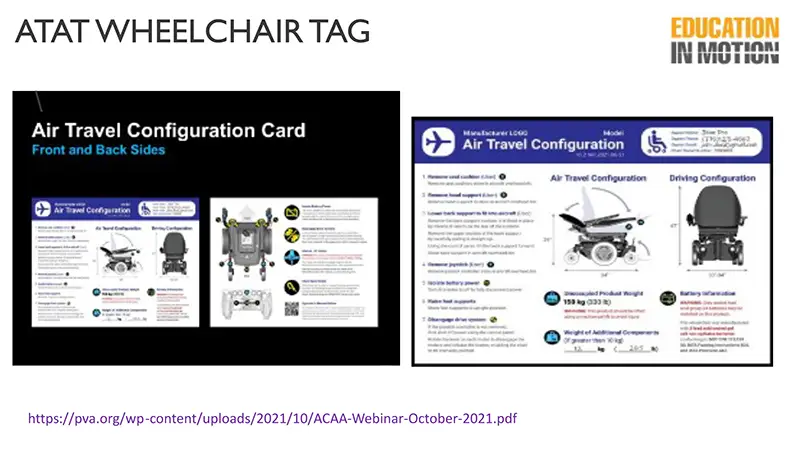
Peter Axelson and Jessica Pedersen developed this tag for NRRTS while they were waiting for the ATAT tag to be voted on and developed. It provides the information that the below-the-wing crew needs to know about the wheelchair. It can be downloaded and filled out with a replacement photo of the wheelchair being used and the desired information.
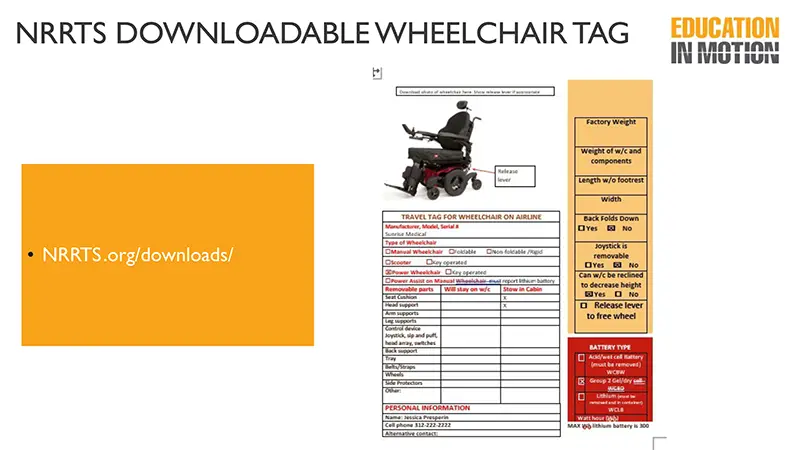
Deplaning
- Wait for the wheelchair to be delivered to the aircraft door before transferring to the boarding chair.
- Inspect wheelchair immediately.
- If you believe your rights have been violated and the airline employee you find at first is unable to help you, ask to speak with a Complaints Resolution Official (CRO). A CRO is the airline's expert on disability accommodation issues. Airlines are required to make one available to you in person at no cost at the airport to by telephone during the times they are operating.
- Complaints can also be filed with the Department of Transportation.
- On domestic flights, U.S. carriers must fully compensate passengers for loss or damage to wheelchairs or other assistive devices without regard to rules limiting liability for lost or damaged baggage.
Testing for Sitting in Wheelchairs in the Cabin
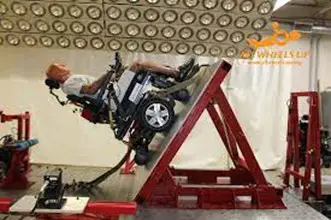
All Wheels Up is an organization founded by Michelle Erwin with the goal of allowing individuals to remain in their own wheelchairs during a flight. All Wheels Up funded crash-testing wheelchairs and wheelchair transit restraint systems for commercial flight. The tests were successful in 2016, leading to legislation supporting feasibility studies and designs for in-cabin wheelchair opportunities.
Designs for in-cabin seating
Several design companies are working with wheelchair manufacturers, aircraft manufacturers, and airlines to establish solutions that would allow wheelchairs to safely fly on an aircraft. The goal is to be able to change a standard airline seat into an area that would accommodate a wheelchair, and then switch back when a wheelchair was not on the flight. A coalition with Air4All, Flying Disabled, and Priestman Goode Design demonstrated an ideas as early as 2022. Delta and Collins Aerospace have also demonstrated their ideas. A video of how this could happen can be seen below.
Policy and Legal Mandates
Air Carrier Access Act (ACAA)
The Air Carrier Access Act was signed into law in 1986, before the American with Disabilities Act. In 2018, the FAA Reauthorization Act had several changes incorporated into it. Tammy Duckworth, a senator from Illinois and manual wheelchair rider, was a leader in pushing for a mandate that airlines must report any loss or damage of durable medical equipment (DME). The yearly data shows significant damage with 11,527 wheelchairs damaged in 2023. No airline wants to be at the top of this list, and this has led to several changes in how airlines train their staff to handle wheelchairs.
Americans with Disabilities Act (ADA)
The Americans with Disabilities Act of 1990 is a civil rights law that prohibits discrimination based on disability. It mandates reasonable access governing airports and organizations focusing on air travel.
Department of Transportation (DOT)
The Department of Transportation has been very active in focusing on traveling with a wheelchair. The All Wheels Up meeting was held at the DOT facility in Boston. Airlines now have passenger accessibility groups which are made up of people with disabilities who provide input for change. The Transportation Research Board funds research teams to focus on feasibility and/or product development. The Access Board consists of invited members of consumer organizations, government entities, research groups, and people with disabilities. The DOT ruling for 2025 supports:
- Safe and dignified assistance
- Mandated training for airline personnel and contractors
- Standards for how to handle damage and loss
- Fines to airlines for not following the FAA Reauthorization Act
- A Disabilities Bill of Rights
- A mandate to begin designing accessible lavatories on single-aisle aircraft
- Groundwork for riders to stay in their wheelchair during flights
RESNA Assistive Technology for Air Travel
The RESNA Assistive Technology for Air Travel Standards was formed in 2015 and is developing standards for airlines and wheelchair manufacturers in an attempt to make traveling with a wheelchair more successful. This includes better online ticketing, mandating that airlines provide information pertaining to cargo holds, stowage of wheelchairs, and labeling on wheelchairs, as well as some wheelchair design regarding removable joysticks. View the standards that are discussed.
International Air Transport Association (IATA)
The International Air Transport Association focuses on all aspects of airline and airport issues, with contributions to standards regarding travel for people with disabilities and stowage of DME.
In summary, this resource and webinar gives readers an overview of the process for traveling with a wheelchair, some of the latest policy information for the U.S., and design ideas for flying while seated in one's own wheelchair.
As things change in this area of interest, Sunrise Medical will keep you posted through blogs and resources.
References
- Atkin, K., Ulahannan, A., Herriotts, P., & Birrell, S. (2023). Accessibility of Air Travel for Passengers With Reduced Mobility: Results of Passenger Focus Groups. Human Factors in Transportation, 95(95).
- Ansley, H. & Axelson, P. (2021). ACAA Webinar. Paralyzed Veterans of America. https://pva.org/wp-content/uploads/2021/10/ACAA-Webinar-October-2021.pdf
- Civil Aviation Authority, CAA Airline Data 2016 Foreword, https://www.caa.co.uk/ 2016.
- Darcy, S. (2012). (Dis)embodied air travel experiences: Disability, discrimination and the affect of a discontinuous air travel chain, Journal of Hospitality and Tourism Management, 19.
- Federal Aviation Administration (nd) PackSafe Wheelchairs and mobility aids with lithium-ion batteries, with batteries installed and protected. https://www.faa.gov/hazmat/packsafe/more_info/?hazmat=35
- Hunter-Zaworski, K., M. Mobility aids and air travel final report Centre of Expertise for Accessible Transportation Canadian Transportation Agency (2019) https://otc-cta.gc.ca/eng/publication/mobility-aids-and-air-travel-final-report
- Katz, D., & Mahomed, A. (2020). An aircraft combination wheelchair seat suitable for aircraft aisles. Journal of Accessibility and Design for All, 10(1), 1–30. https://doi.org/10.17411/jacces.v10i1.248
- National Academies of Science Engineering and Medicine. (2021) Technical feasibility of a wheelchair securement concept for airline travel. Transportation Research Report, Special Report 231, National Academies Press, Washington DC
- Peck, M. P. (2021). Canada The Time has Come, the Walrus Said to talk about Many Things: Wheelchair Securement Spaces on Commercial Airlines. Canadian Journal of Disabilities Studies 10(3)
- Pfeiffer, J. L., Bower, W., & Rumrill, P. (2024). Investigating the challenges of air travel in the United States: a qualitative study of the lived experiences of wheelchair users with spinal cord injury or disorder. Spinal Cord Series and Cases, 10(1), 25.
- Presperin Pedersen J. (2019) Leaving on a Jet Plane: What Professionals in the Wheelchair Industry Need to Know. Canadian Mobility and Seating Conference, Invited Plenary Speaker
- Presperin Pedersen, J. (2019). Protecting the wheelchair on a commercial flight: How people from the wheelchair industry can help. Directions Magazine, 2, 27–34.
- Presperin Pedersen J. (February 2020). Air travel with a wheelchair: Occupational therapy's role in facilitating successful flights. AOTA Continuing Education Article https://www.aota.org/
- Presperin Pedersen J. (2019) Air travel for people who use wheelchairs: Survey results- Paper, ACRM Annual Conference, Nov 4-8 Chicago
- Presperin Pedersen J. (2018) Flying with a wheelchair: What the wheelchair supplier needs to know. NRRTS Webinar
- Presperin Pedersen J, & Shea M. (2018) Leaving on a jet plane: Will I see my chair again? European Seating Symposium, Dublin, Ireland
- Presperin Pedersen J., & Shea M. (2017). Air Travel with a Wheelchair: What Seating Experts Should Know. Proceedings 33nd Annual International Seating Symposium 2017 Nashville, TN
- Presperin Pedersen, J., & Axelson, P. (2016). I'm leaving on a jet plane. I hope I'll see my chair again. In Proceedings from 32nd International Seating Symposium: Imagine the Possibilities, Vancouver, British Columbia: University of British Columbia. 247-253.
- Shea, Mary & Dyson-Hudson, Trevor. (2016). Tips and Tricks for Successful Air Travel, On the Move – A Consumer Conference for People with Spinal Cord Injury, West Orange, NJ, September 23, 2016.
- United Spinal Association. (2013). Accessible air travel: A guide for people with disabilities. Kew gardens, NY: United Spinal Association.